Shopify is a specialized e-commerce platform with a built-in blogging functionality and the possibility to add a ton of integrations. An example of its popularity is that it comes in second place, right behind WordPress, in terms of the number of websites on the internet that use Shopify. The name is synonymous with e-commerce.

Squarespace is primarily a site builder with blog functionality and added e-commerce features. It’s one of the most widely known and used site builders. Popularity-wise, Squarespace is virtually on par with Shopify.
As a general site builder with e-commerce tools, Squarespace has a wider appeal than Shopify in terms of its use cases, which can be a huge advantage.
It can work well for anyone who needs a swiss-army-knife type of platform. However, since it’s not a specialized e-commerce platform, you know that you won’t find as many advanced e-commerce features as with Shopify.
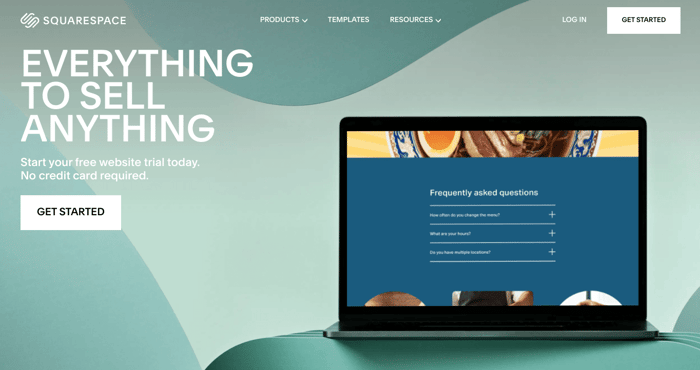
From the get-go, it’s clear that these two platforms will appeal to slightly different users. Which one would be a better fit for your business? Our Shopify vs. Squarespace guide will hopefully help you come to a conclusion.
| A quick guide: | ||
| Shopify | Squarespace | |
| Pricing plans |
|
|
| Templates |
|
|
| Editors |
|
|
| Integrations |
|
|
| Blogging |
|
|
| Support |
|
|
Table of Contents
Pricing Plans and Transaction Fees
Squarespace is more affordable than Shopify, but lower prices are not the only thing that should be factored in when deciding between two e-commerce solutions. The number and quality of e-commerce features are just as important as your particular business needs.
Keeping that in mind, let’s explore the pricing systems of Shopify and Squarespace and see how they compare to each other.
Shopify
This is a summary of the Shopify pricing system:
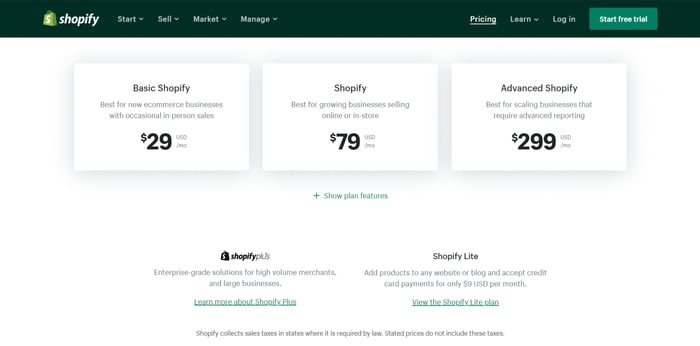
The only thing that’s missing from the image is the 14-day free trial. You can sign up to test drive the platform without leaving your credit card information, which is something we really like. When you start with a free trial, you don’t have to select a particular pricing plan from the start – you can choose one later.
Speaking of which, as we saw in the image, there are five Shopify pricing plans – three standard and two special. Let’s look at the standard ones first.
Basic Shopify
The Basic Shopify plan is geared toward newcomers in the e-commerce niche. It provides you with the necessary tools to get your store up and running and begin your business adventure.
Some of its noteworthy features are:
- Unlimited products – list and sell as many products as you want.
- Multichannel selling – sell on online marketplaces like Amazon and social media like Facebook.
- Abandoned cart recovery – Shopify automatically sends reminders to your store visitors who don’t follow through on a purchase to help you increase your sales.
- Shopify POS Lite – Shopify’s own point-of-sale system that enables you to accept in-person payments.
- Two staff accounts – share your workload with another staff member who can have privileged access to the Shopify admin area as well as the Shopify POS.
These are all great features, but the one that stands out the most is the Shopify POS system. The ability to sell offline and online for less than $30 per month is excellent news for any brick-and-mortar store owner who wants to have an online presence.
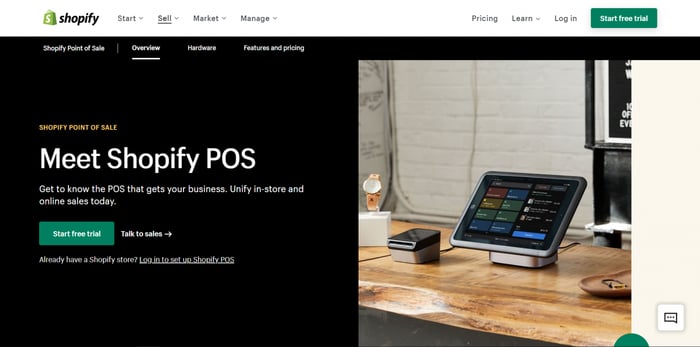
Two more features available with this and every other plan are the ability to sell in twenty languages and 133 currencies.
Shopify
The Shopify plan is great for business owners with a certain amount of experience in the niche. With that in mind, it gives you access to the following important features:
- E-commerce reports – track different stats related to your store.
- USPS Priority Mail Cubic pricing – save on shipments by getting discounts on shipping large quantities of small but weighty packages with the United States Postal Service.
- International domains – use country domains for your online store for better SEO optimization.
- International pricing – price your products according to your customers’ countries and regions.
- Five staff accounts – expand your team with more members for more effective collaboration and more challenging projects.
This plan enables you to customize your business with custom prices and international domains to run more efficiently.
Advanced Shopify
If your business is growing at a steady rate and you need features that can follow this growth, the Advanced Plan is something you might want to consider. It includes features like:
- Advanced reports – use custom analytics reports on top of the standard ones you get with the Shopify plan.
- Third-party calculated shipping rates – show shipping rates from third-party carriers to your customers at checkout.
- 15 staff accounts – collaborate with an even larger team and assign different levels of permissions to your staff.
- Customized international pricing – use custom prices for individual products based on countries and regions.
Shopify Starter
Shopify Starter is a special plan that helps users who already own websites elsewhere (for instance on WordPress or Squarespace) to take advantage of Shopify’s features. More precisely, this plan allows you to:
- Add a buy button to your site to sell products.
- Utilize its POS (point-of-sale) system to accept payments in person.
- Create different orders (wholesale, phone, and custom) and send email invoices to customers.
- Gain better business insights thanks to the Shopify reporting features.
- Use gift cards to build even stronger relationships with your customers and expand your audience.
Since this is not a fully-fledged Shopify plan, you can enjoy some of the benefits Shopify offers, but you won’t be able to build a complete e-commerce store.
Shopify Plus
Shopify Plus is the most advanced pricing plan. It’s a custom plan geared toward large businesses, enterprises, and renowned brands (such as Heinz). The price starts at a hefty $2,000 per month. However, the pricing is customizable, so it can go higher depending on your business requirements and needs.
Transaction Fees
Shopify provides its own payment processing option called Shopify Payments. One of the benefits of using Shopify Payments is that you don’t need to pay transaction fees.
Unfortunately, this payment processor is not available everywhere, so in case you can’t or choose not to use it, these are the transaction fees Shopify charges with the three standard plans:
- Basic Shopify: 2.0% per sale
- Shopify: 1.0% per sale
- Advanced Shopify: 0.5% per sale
For more on transaction fees and other charges, take a look at this Shopify article.
It’s good to know that Shopify allows you to use more than 100 payment gateways, including PayPal, Amazon Pay, and Apple Pay, depending on your country/region. For a complete list of available payment gateways in your country, have a look at Shopify’s online payment gateways page.
Squarespace
The Squarespace pricing system consists of four standard pricing plans and one special plan. Unlike Shopify, Squarespace’s subscription fees can be paid in two ways: monthly or annually. Let’s have a look at some of the specifics of the four standard plans:
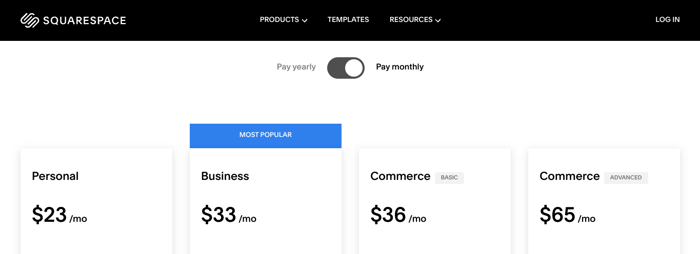
With the annual discounts, the prices are significantly lower:

An annual subscription saves you $84 with the Personal plan, $120 with the Business plan, $108 with the Basic Commerce plan, and $192 with the Advanced Commerce plan.
Squarespace allows you to test out the platform for two weeks, and just like with Shopify, the free trial doesn’t require your credit card information. What’s great about the free trial is that it gives you access to most of the premium features and all the custom code options – such as the CSS editor, embed blocks, and code injection.
Besides the two Commerce plans, the Personal and Business plan also provides some rather essential e-commerce features. Let’s look at the Squarespace pricing plans more closely.
Personal
Even though our focus is on e-commerce, we’ll say a couple of words about the Squarespace Personal plan as well.
This plan allows you to start working on your online presence by building a website and tracking some basic site metrics. In addition, with the Personal plan, you get:
- Unlimited bandwidth and storage – no limits when it comes to your website traffic and storage space.
- Two contributors for collaboration purposes.
- SEO features to make your site more visible to search engines and users.
- Ability to add integrations from the list of official Squarespace extensions.
- A free custom domain for one year (only with the annual subscription).
Business
In addition to the set of core features, the Business plan provides you with marketing and commerce features as well as more customization options. These are some of the noteworthy features of the Business plan:
- Advanced analytics – website visits, favored content, and other sales and conversion stats.
- E-commerce tools – product, order, inventory, payment, shipping, and tax management.
- Unlimited products – there’s no limit to the number of products you can sell.
- Gift cards – offer gift cards that your customers can give away to friends and family.
- Advanced customization with CSS and JS (use code to modify your site and make it even more in line with your personal preferences).
Basic Commerce
Things are starting to get more serious with the Basic Commerce plan. It includes all the e-commerce features from the Business plan, plus the following important tools:
- A POS system (available only for in-person selling in the U.S.).
- Customer accounts – allow you to create a stronger connection with your customer base and increase repeat purchase rates.
- Powerful e-commerce analytics tools – best-selling products, sales trends, and conversion tracking stats.
- Helpful merchandising tools – for example, show related customers' products, let customers join product waitlists, and do spreadsheet bulk inventory editing.
- Sell on Instagram – extend your reach by offering products from your e-commerce store on one of the most popular social media apps.
Advance Commerce
The advanced Commerce plan offers features like:
- Abandoned cart recovery – automated email messages that prompt customers to complete their purchase process.
- Advanced discount options – automatic discounts for orders that meet certain predefined criteria, limits on discount use per customer, and limits on total discount uses.
- Subscriptions – allow your audience to buy subscriptions to your products.
- Advanced shipping options – give you the ability to automatically calculate shipping rates for different carriers.
- Access to the Squarespace commerce APIs – Orders API, Inventory API, Products API, Transactions API, and Webhook subscriptions API. They enable you to link up different aspects of your store with third-party services.
With features like these, Squarespace aims to meet even the needs of more demanding e-commerce businesses and business owners.
Squarespace Select
This plan is like Squarespace’s version of the Shopify Plus plan. It’s a custom plan geared primarily toward established businesses and enterprises. Its purpose is to allow you to personalize and customize as many facets of your business and store as possible.
Squarespace Select costs a sizable $4,900 per year, and the features are negotiable based on your requirements.
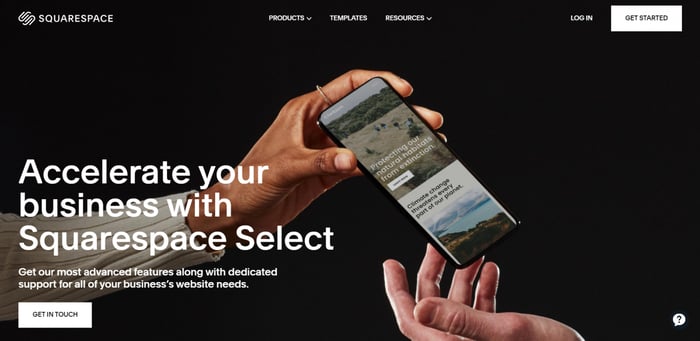
Transaction Fees
Neither of the two commerce plans charges transaction fees per sale. The only Squarespace plan that includes a 3% transaction fee is the Business plan. For credit card fees and other charges, check out this Squarespace article.
Squarespace doesn’t have its own payment gateway; you can accept payments via Stripe, PayPal, Apple Pay, and Afterpay. For in-person purchases, it allows you to use Square.
Templates
Shopify
Shopify offers over 100 online store templates or, as Shopify refers to them, themes. They’re responsive, customizable, and professional-looking. However, they might not offer you enough freedom to create really individual designs if that’s important for your business.
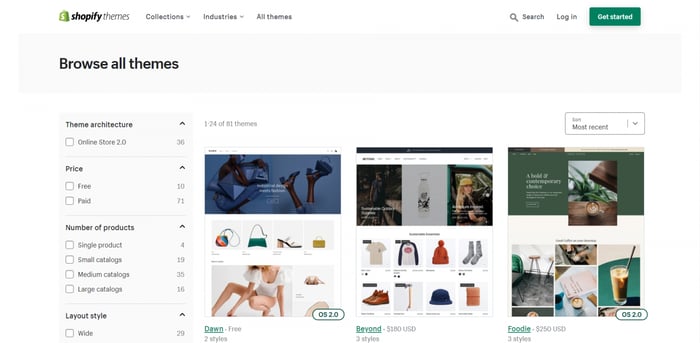
The paid templates are pricey. The cheapest ones cost $150, while the most expensive are $350. Luckily, it’s a one-time payment, so you won’t have to worry about recurring monthly or yearly costs.
For users who don’t feel like paying that much for a template, there are 10 free options to choose from. The free templates look great and are often designed for a particular target audience. For instance, this is one of the free templates called Brooklyn, designed for clothes stores:
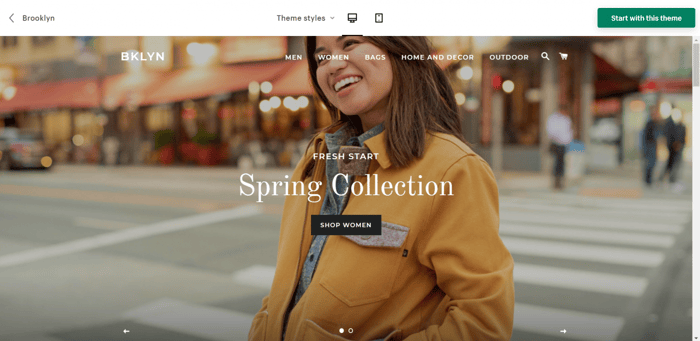
Shopify helps you make the right choice by offering various theme filters:
- Number of products – one product, small catalogs, and large catalogs
- Layout style – wide, grid, collage
- Product page – image zoom, gallery, and HD images
- Home page – slideshow, customer testimonials, and video
- Navigation – sidebar menu, horizontal menu, and multi-column menu
- Marketing and social media – Twitter feed, promotional banner, and marketing pop-up
- Industry – art and photography, electronics, and sports and recreation
The Shopify templates are optimized for fast load times, so you won’t have to worry about losing your potential customers to a slow page. This, along with the aesthetics and features, makes the Shopify templates an invaluable asset in your e-commerce toolkit.
Squarespace
The total number of Squarespace templates is much higher, but only about twenty are designed specifically for online stores. Just like Shopify’s templates, they’re all customizable and responsive.
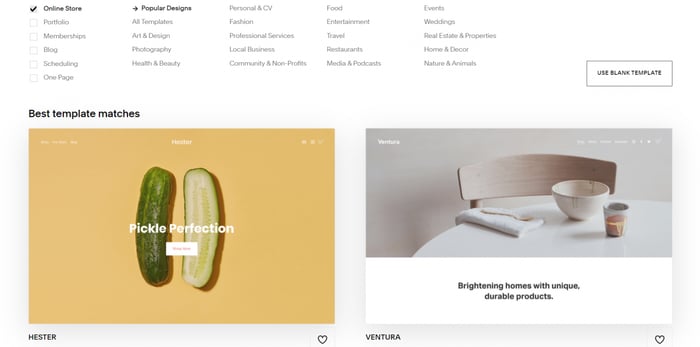
The limited choice of templates can mean that many Squarespace stores would look similar. However, considering that the templates are customizable and that there are different code customization options on top of the visual editor, you’ll have more than enough to make your store different and reflective of your brand.
In our opinion, the templates found in the Shopify theme store are designed a bit better, but the Squarespace online store templates have pretty good aesthetics as well. Check out this Squarespace template called Vance:
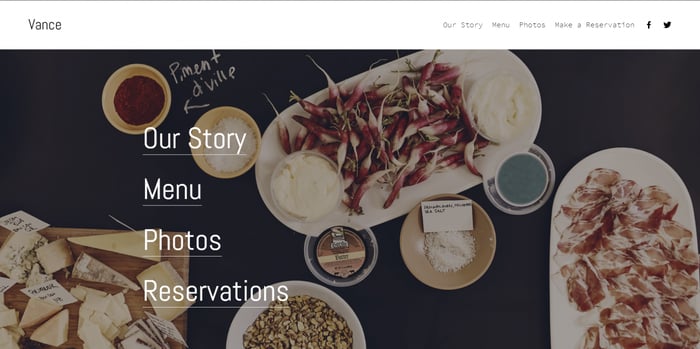
The best part about the Squarespace templates is that they’re all free, regardless of whether they were designed for online stores or other use.
If you know your way around design, Squarespace even allows you to use a blank template and build your store from the ground up.
Squarespace also has filters to help you narrow down options and find a template that’s a good fit for your business. However, these filters apply only to the Squarespace templates, not specifically to online store templates.
Editors
Shopify
How your storefront looks is as important as the functionalities it includes. Choosing a suitable template for your business is only half the job. The next logical step is to customize your store design. That’s where you need a good editor with a reasonable number of customization options.
This is the Shopify editor in action:
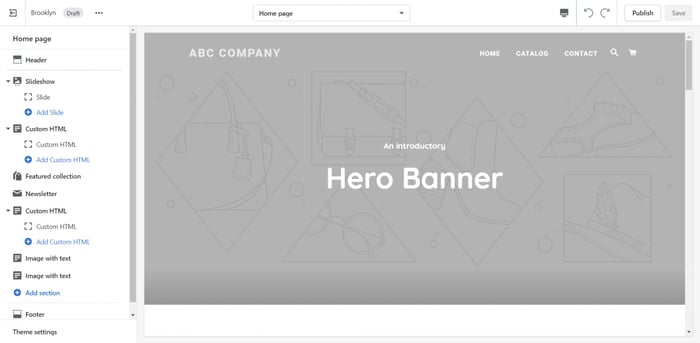
Alongside the options you can see on the left in the image above, you can:
- Edit the template code files
- Edit the store language
- Preview your storefront on a mobile and desktop device
- Tinker with colors
- Customize typography
- Modify the cart page
- Add social media
- Upload a favicon
- Make small changes to your checkout
- Choose between a few template styles
The Shopify editor is extremely intuitive, clean, and easy to use. It offers plenty of customization options and the possibility to make the template you chose truly your own.
Squarespace
Due to Squarespace being primarily a site builder – a pretty flexible one at that – we have to say that it offers more customization and style options, especially regarding no-coding-involved options.
The Squarespace editor belongs to the group of drag-and-drop editors. For instance, after you’ve added a new element, such as a button, you can reposition it by dragging and dropping it to where you want it to be.
By scrolling over your page while it’s open in the editor, you can see some of the options it includes – for instance, adding a new section or an element. Editing is simple: just click on the part you want to customize, and you’ll see a menu with new options.

These are some of the actions you can perform inside the Squarespace editor:
- Experiment with colors and positioning
- Duplicate sections
- Preview your site/store on a desktop and mobile device
- Change the background
- Edit the text alignment
- Add buttons, text, videos, images, code, social links, and forms
- Change the size of an element
- Change the heading
- Change fonts
- Tinker with animations
However, to turn your site into an e-commerce site, you need to add a store to it from within the dashboard.
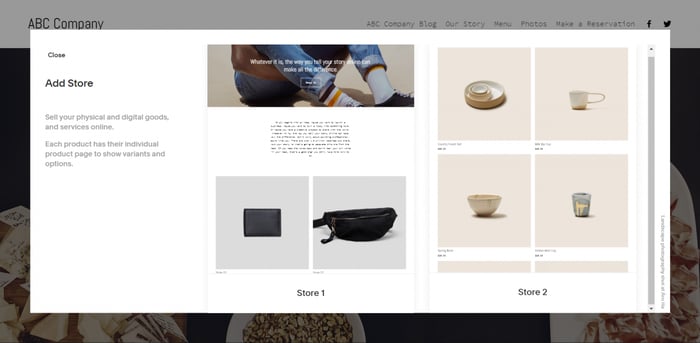
It’ll show up as a separate page of your website. When you’re done, you can start customizing your store in the visual editor.
Everything that we said about the Squarespace editor and customization options before applies here as well. It’s the same editor, the same editing process, and the same options.
Integrations
Shopify
When it comes to integrations, the Shopify App Store has a myriad of them. You’ll be hard-pressed to find a tool you need that the store doesn’t have.
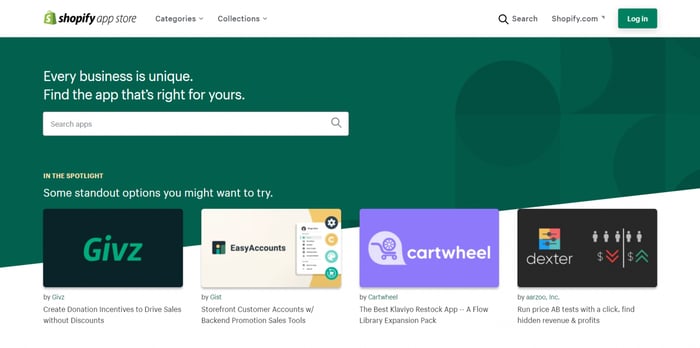
There are nine categories of app integrations:
- Sourcing and selling products
- Store design
- Merchandising
- Marketing
- Conversion
- Fulfillment
- Shipping and delivery
- Customer service
- Store management
They’re further divided into subcategories. For instance, the category of conversion is divided into six groups of apps: store alerts, customer feedback, cart modification, upselling and cross-selling, promotions, and recovering orders.
An alternative way to search through all the apps is via the so-called “collections.” There are eight of them, and they can be very helpful and save you time when looking for a specific type of app:
- Launching your store
- Growing your business
- Works with Shopify POS
- Works with Shopify Marketing
- Top email marketing solutions
- Made by Shopify
- Sales channels
- Works with Shopify Checkout
It’s worth noting that many of the integrations are free to install or free to use or include a free plan. So, no matter what your budget is, you can still take advantage of the wealth of Shopify integrations.
Squarespace
Squarespace doesn’t have a special app store or as many integrations as Shopify, but that doesn’t mean that it has nothing to offer in the integrations department. The place to find information on this topic is the Squarespace help center.
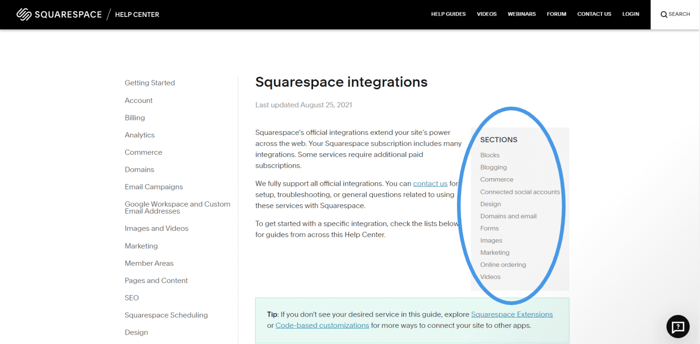
The official Squarespace integrations are grouped into 11 categories, and they coincide with the names of the sections in the image above.
In case you can’t find something you need, Squarespace suggests checking out the Squarespace extensions (not to be confused with integrations). The extensions fall within four categories:
- Finance
- Inventory and products
- Sales and marketing
- Shipping and fulfillment
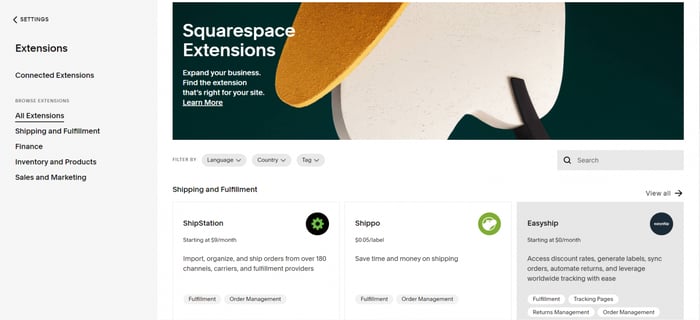
What’s the Difference Between Integrations and Extensions?
Integrations are apps that are fully supported by Squarespace. Most of them are included in the pricing plans. For those that are not, you need to pay to use them.
In contrast, extensions are third-party apps that are supported or “built and managed” by third-party vendors. For the full list of extensions, check out this Squarespace article.
In addition, you can add code-based functionalities like Adsense and Facebook Pixel and even use the Squarespace APIs to build your own integrations.
Blogging
Shopify
Among many other tools, Shopify includes a native blogging solution as well. It’s a built-in feature that was made for occasional blogging.

The Shopify blog is a decent tool, but it doesn’t include much beyond essential features.
If you plan on using your blog as a powerful brand-building, traffic-boosting, and conversion tool, the recommended way is to use third-party software developed exclusively for blogging. One such tool is DropInBlog, which is a modern blogging solution with a variety of helpful features. This SEO-friendly blogging platform should definitely do the trick.
Squarespace
Squarespace allows you to add a new blog page and choose from a few different layouts:
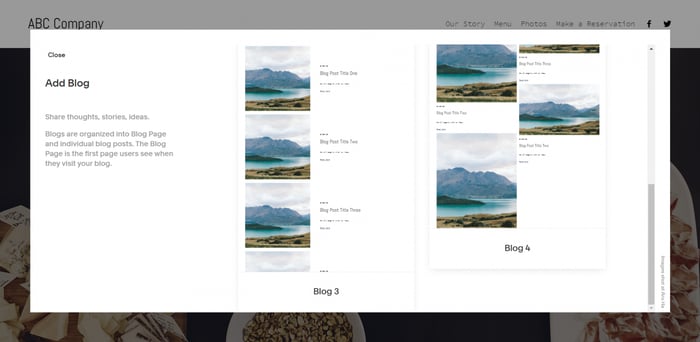
Unlike Shopify, Squarespace offers far more possibilities for building a nice blog. These are some notable things you can do with the Squarespace native blogging solution:
- Optimize the URL slug
- Add SEO title and description
- Upload a social sharing image
- Manage categories and tags
- Inject code

On top of this, Squarespace offers publishing your blog as a separate channel in Apple News, using Disqus as a commenting system, and utilizing AMP (Accelerated Mobile Pages) formatting for your blog posts.
Of course, if you’d prefer to use a third-party blogging platform, you can easily embed DropinBlog to your Squarespace site as well.
Support
Shopify
One of the biggest assets of Shopify is its phone support. The company’s customer support team is available 24/7, and, in addition to phone, you can use email and chat to contact them.
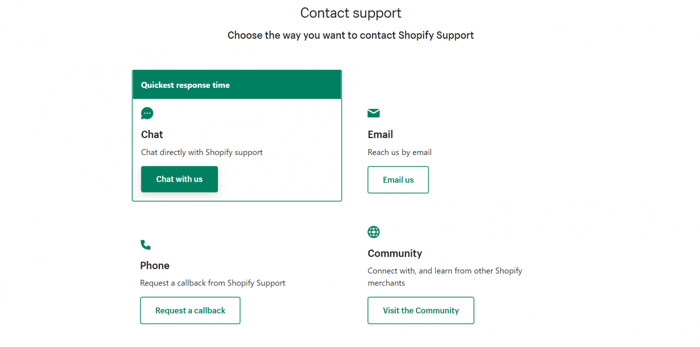
Another way of getting help and learning more about the platform is to either check out the Shopify community page or visit the help center, where you can find even more helpful resources.
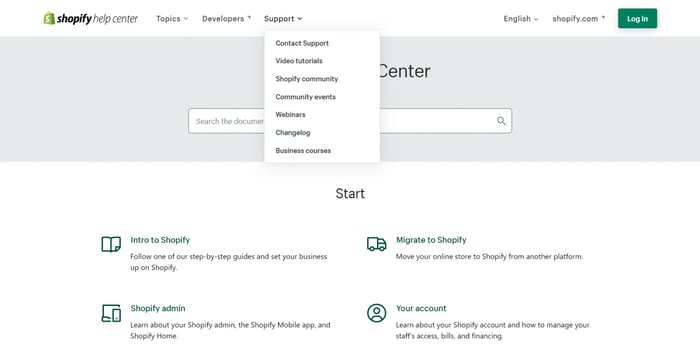
Squarespace
Squarespace provides direct support through email (24/7) and live chat (business days, from 4 a.m. to 8 p.m. EST). There’s no phone support, but similar to Shopify, you can find help and useful information in the Squarespace help center, where you can find useful articles and pages.

FAQs
Do Shopify and Squarespace work together?
Yes. You can connect Shopify with Squarespace and vice versa. By simply using a bit of code or adding a Buy button that links to your Squarespace site, you can connect the two. What’s more, you don’t have to choose between the two – you can have both.
Does Squarespace take a cut of my sales?
Almost uniquely, Squarespace does not charge transaction fees across the board. It’s only with the Business plan that there’s a 3% transaction fee included. Both of the commerce plans are completely transaction fee-free.
Is dropshipping possible with Squarespace?
Dropshipping with Squarespace is possible. There are currently five fulfillment service options to choose from:
- Art of Where
- Printful
- Printique
- ShipBob
- Spocket
- Syncee
Do Shopify and Squarespace allow for creating blogs?
You can create a blog page on both Shopify and Squarespace. Squarespace offers a much nicer, user-friendly blogging option, but if you aren’t happy with either, you can always integrate a specialized third-party blogging platform.
Final Thoughts
To conclude, Shopify is for long-term and serious e-commerce-focused projects. It can be both a great choice or overkill, depending on whether you really need everything it offers or not.
Squarespace won’t have all the e-commerce solutions Shopify does. It likely won’t meet the demands of a larger and highly developed online business. However, it’s a much more suitable solution for smaller stores or someone who wants a more adaptable platform. It works well for artists and creatives, as its track record shows.
So, which one would work better for your business?




